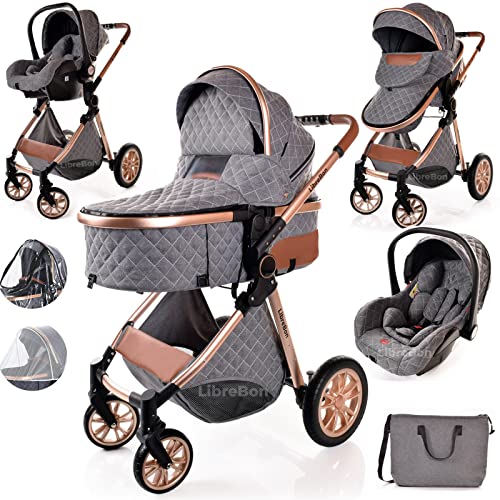Prams and Pushchairs: A Comprehensive Guide for New Parents
Navigating being a parent involves a wide variety of decisions, one of the most considerable being the option of an ideal pram or pushchair. These important products work as a haven for babies and a means of transport for caregivers. Whether strolling through Prams Online or running errands, an excellent pram or pushchair can boost the experience for both parent and kid. This post provides a thorough look at the kinds of prams and pushchairs offered, their features, and important factors to consider to make before buying one.
Comprehending Prams and Pushchairs
While the terms "pram" and "pushchair" are typically used interchangeably, they describe slightly various products. Comprehending the difference can assist in making an educated option.
| Term | Description |
|---|---|
| Pram | Normally created for infants, prams have a fully flat structure, enabling the baby to lie down easily. Full Survey include a carrycot and appropriate for newborns approximately about 6 months old. |
| Pushchair | Created for older babies and toddlers, pushchairs frequently have a more upright seating position. They are flexible and can generally be reclined or gotten used to cater to the kid's growth, starting from around 6 months and reaching preschool age. |
Types of Prams and Pushchairs
When selecting a pram or pushchair, various styles will accommodate different parenting requirements and lifestyles. Here are the primary types offered on the market:
Traditional Prams
- Classic, classic styles with a tough carrycot.
- Ideal for newborns.
- Typically bulkier, ideal for leisurely strolls.
Pushchairs
- Light-weight and often foldable, best for travel and fast getaways.
- Can be front-facing or rear-facing.
- Consist of features like adjustable handlebars and reclining seats.
Travel Systems
- A combination of an automobile seat and a pushchair.
- Practical for car-to-pushchair shifts without disturbing the baby.
- Normally more expensive but worth thinking about for their multifunctionality.
Multi-Functional Strollers
- Deal different setups, permitting for a carrycot, sit-up seat, or vehicle seat accessory.
- Versatile as per the child's development and changing requirements.
- Can often be utilized for multiple children with accessories.
Light-weight Strollers
- Ultra-portable, ideal for moms and dads on the go.
- Easy to fold and carry.
- Generally recommended for older babies or young children.
Key Features to Consider
When selecting the ideal pram or pushchair, a couple of crucial functions should be taken into account:
Safety Features
- Search for a five-point harness system to secure the kid.
- Models with braking systems that are easy to operate with the foot deal added security.
Weight and Size
- Think about just how much weight the caretaker can manage, and the storage area readily available.
- A lightweight design might provide easier maneuverability, while a bulkier model might offer better stability and durability.
Durability and Material
- A frame made from high-quality materials guarantees longevity.
- Weather-resistant fabrics can provide convenience and ease of cleansing.
Relieve of Folding
- Designs that can be folded rapidly and quickly are typically preferred, specifically for parents who require to utilize public transportation or have restricted storage area.
Handling and Comfort
- Adjustable handles can accommodate various heights, making sure a comfy push for all caregivers.
- Good suspension is necessary for smoother trips on uneven surfaces.
Preparing for the Purchase
Before buying, it's advisable to conduct extensive research. The following steps will help brand-new moms and dads make an informed choice:
Define Your Needs
- Consider lifestyle elements such as travel frequency, urban vs. suburban living, and storage area.
Budgeting
- Prams and pushchairs vary significantly in price. Set a reasonable budget, bearing in mind security and quality.
Test Drive
- Whenever possible, evaluate the pram or pushchair. Focus on weight, maneuverability, and overall comfort.
Moms And Dad and Baby Reviews
- Search for feedback from other parents who have actually utilized the product. This can supply insights into real-world efficiency.
Examine for Warranty
- An excellent service warranty can secure your financial investment and guarantee longevity.
FAQs
Q1: At what age can a baby use a pushchair?Typically, babies can
begin using a pushchair around 6 months when they can hold their head up independently. Prior to that, a pram or carrycot is advised. Q2: Are travel systems worth the investment?Yes, travel systems can provide great worth for parents who require a smooth transition in between the
car and stroller. They provide benefit and flexibility, especially for households who often travel. Q3: How long can you use a pushchair?Most pushchairs can be used till a child is around 3 to 4 years old, though some models provide features for larger children. Q4: Do I require a new pram or pushchair for each child?If your existing design remains in good condition and satisfies safety standards, there may be no requirement for a brand-new one. Nevertheless, consider factors like wear and tear, hygiene, and progressing requirements. Choosing the best pram or pushchair is a key decision for any brand-new moms and dad. With a range of designs, types, and includes readily available, parents can discover a design that fits their needs, lifestyle, and budget plan.
By researching and comprehending the distinctions in between prams and pushchairs, moms and dads can make a confident and informed choice that will provide the best, most practical experience for their child. As they start this exciting journey of being a parent, having the best transportation choice can genuinely enhance the experience of raising a kid.

